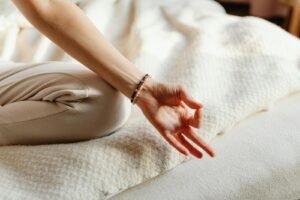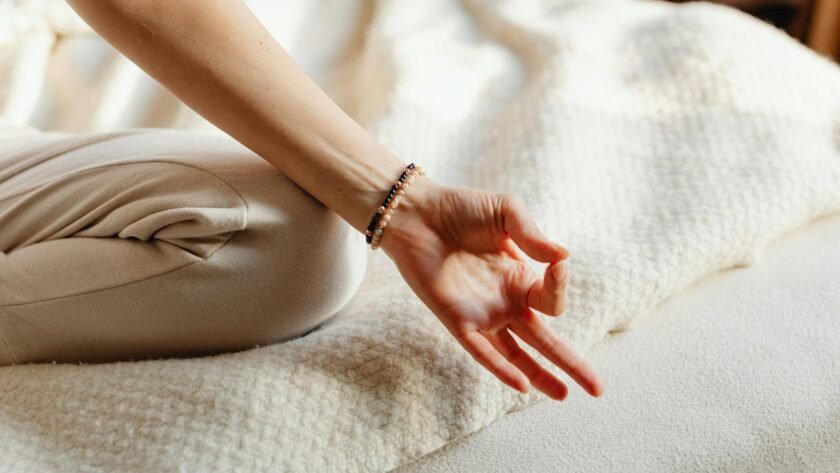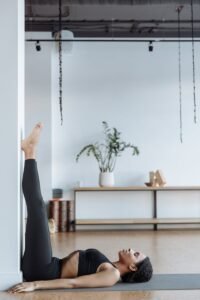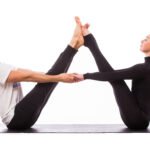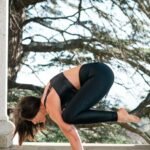Quick Guide for Busy People : Bedtime Yoga for Beginners
- Start with Ujjayi Pranayama: Take deep breaths to calm your mind.
- Child’s Pose: A restorative posture to unwind your body.
- Legs Up the Wall: Relieve stress and enhance blood flow.
- Reclined Butterfly: Open your hips and chest for deep relaxation.
- Corpse Pose: Final relaxation to melt away the day’s tension.
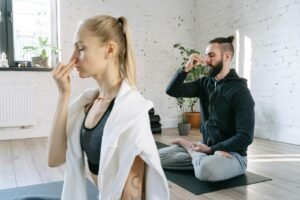
Introduction
Finding it hard to fall asleep? A beginner’s bedtime yoga routine could be your key to unlocking deep, restful sleep. This comprehensive guide will take you through simple yoga poses designed to calm your mind and prepare your body for a night of quality sleep. Let’s dive into how these poses can transform your nightly routine.
Why Bedtime Yoga?
Yoga before bed helps you wind down, relax, and sleep better. The slow-paced, mindful practice involves gentle stretches, deep breathing, and guided relaxation that lowers heart rates and shifts you into a tranquil state.
Importance of Sleep Cycle: Understanding the sleep cycle is crucial. A bedtime yoga routine can enhance this cycle, starting with light sleep, moving into deep rest, and then hitting REM (Rapid Eye Movement) stages repeatedly throughout the night.

Essential Bedtime Yoga Poses
These poses are perfect for beginners and should be performed in comfortable clothing and a serene environment:
-
Ujjayi Pranayama (Breath Control):
-
Steps:
- Sit comfortably.
- Inhale deeply through your nose.
- Exhale slowly, creating a soft “ha” sound.
- Repeat for 5 minutes to reset your nervous system.
-
Benefits:
- Calms the mind.
- Reduces stress.
- Prepares your body for the next poses.

Photo by anuppanthi on Pixabay -
-
Child’s Pose (Balasana):
-
Steps:
- Start on your knees.
- Separate your knees, big toes touching.
- Sit back on your heels and stretch your arms forward.
- Hold for 5 minutes, focusing on your breath.
-
Benefits:
- Stretches the back.
- Promotes relaxation.
- Reduces fatigue.
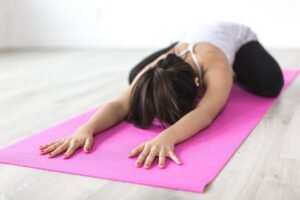
Photo by StockSnap on Pixabay -
-
Legs Up the Wall (Viparita Karani):
-
Steps:
- Sit close to a wall.
- Lie back and swing your legs up onto the wall.
- Keep legs straight and relax arms by your sides.
- Hold for 5-10 minutes.
-
Benefits:
- Improves circulation.
- Relieves stress.
- Calms the nervous system.
-
-
Reclined Butterfly (Supta Baddha Konasana):
-
Steps:
- Lie back, bending knees, soles of feet touching.
- Let knees fall open to sides.
- Place a pillow under your knees for support.
- Hold for 3-5 minutes.
-
Benefits:
- Opens hips.
- Relaxes chest.
- Promotes deep breathing.
-
-
Corpse Pose (Savasana):
-
Steps:
- Lie flat on your back.
- Spread legs slightly apart.
- Place arms at your sides, palms up.
- Close your eyes and relax for 5-10 minutes.
-
Benefits:
- Reduces insomnia.
- Eases headaches.
- Deep relaxation.
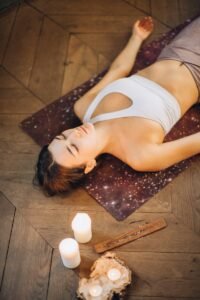
Photo by Elina Fairytale on Pexels -
Creating the Perfect Environment
- Lighting: Use dim lamps or candles.
- Temperature: Slightly cool, around 65-68°F.
- Aromatherapy: Lavender or chamomile essential oils can enhance relaxation.
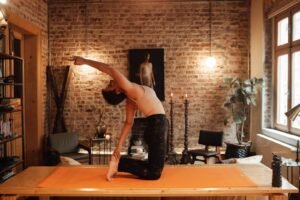
Detailed Instructions for Each Pose
For those looking to delve deeper, here are step-by-step instructions along with tips on getting the most out of each yoga pose:
-
Ujjayi Pranayama:
- Initial Setup:
- Seated in a comfortable position, ensure your back is straight.
- Close your eyes and place your hands on your knees or in your lap.
- Performance Tips:
- Keep your breath smooth and even.
- Focus on the sound of your breath; it should be audible but soothing.
- Duration:
- Practice for 5-10 minutes or until you feel a noticeable sense of calm.
- Initial Setup:
-
Child’s Pose (Balasana):
- Initial Setup:
- Kneel on the floor, big toes touching, knees spread apart.
- Stretch your arms forward, palms facing down.
- Performance Tips:
- Breathe deeply into your back and ribcage.
- With each exhale, try to sink your hips closer to your heels.
- You can place a pillow underneath your torso or forehead for extra support.
- Duration:
- Hold the pose for 5 minutes, breathing deeply.
- Initial Setup:
-
Legs Up the Wall (Viparita Karani):
- Initial Setup:
- Sit sideways to the wall with your legs bent.
- Swing your legs up as you lower your back onto the floor, coming into an L-shape.
- Performance Tips:
- Align your body so your hips are close to the wall.
- Relax your arms out to the sides or place them on your stomach.
- Use a folded blanket under your hips for added comfort.
- Duration:
- Stay in this pose for 5-10 minutes.
- Initial Setup:
-
Reclined Butterfly (Supta Baddha Konasana):
- Initial Setup:
- Lie flat on your back, bend your knees with the soles of your feet touching.
- Let your knees drop open naturally to the sides.
- Performance Tips:
- Use pillows or bolsters under your knees for added support and to avoid strain on the hips.
- Rest your arms comfortably at your sides, palms facing up.
- Focus on breathing deeply and evenly.
- Duration:
- Hold for 3-5 minutes, focusing on opening the chest and hips.
- Initial Setup:
-
Corpse Pose (Savasana):
- Initial Setup:
- Lie on your back with your legs straight and slightly apart.
- Arms should be relaxed by your sides, palms facing up.
- Performance Tips:
- Close your eyes and scan your body for tension, consciously relaxing each muscle.
- Maintain deep, slow breathing without controlling it too much.
- Stay still to fully embrace the state of relaxation.
- Duration:
- Rest in Savasana for 5-10 minutes or until you feel completely at ease.
- Initial Setup:
Tips for Sustaining a Consistent Bedtime Yoga Routine
- Set a Regular Time: Practice at the same time each night to establish a sleep-inducing routine.
- Create Rituals: Pair your yoga with calming activities like reading or taking a warm bath beforehand.
- Track Your Progress: Use a journal to note how you feel before and after your practice.

FAQ Section
-
Do I need prior yoga experience for these bedtime poses?
- No, these poses are suitable for complete beginners. The key is to focus on your breath and listen to your body’s needs.
-
How long should I practice bedtime yoga?
- Aim for 15-30 minutes of practice each night. Start with shorter sessions if needed and gradually increase the duration as you become more comfortable.
-
Can I do these poses in bed?
- Absolutely! Many of these poses, like Legs Up the Wall and Corpse Pose, can be easily done right in your bed for maximum convenience.
-
What if I have an injury or physical limitation?
- Modify the poses as needed, using props like blocks, straps, or extra pillows. Avoid any movements that cause pain or discomfort. Consult a yoga instructor or healthcare professional if you have concerns.
-
How soon will I see results from a bedtime yoga routine?
- Everyone’s sleep patterns and stress levels are different, but most people report feeling more relaxed and sleeping better within 1-2 weeks of consistent practice.
-
Can I do this routine every night?
- Yes, these poses are designed to be done daily as part of a healthy sleep hygiene routine. Consistency is key for maximizing the benefits.
